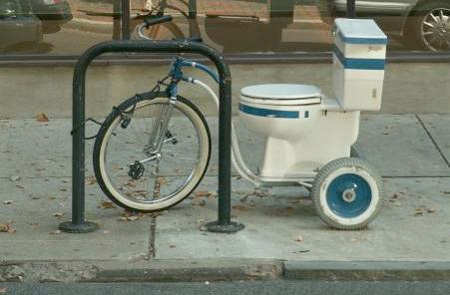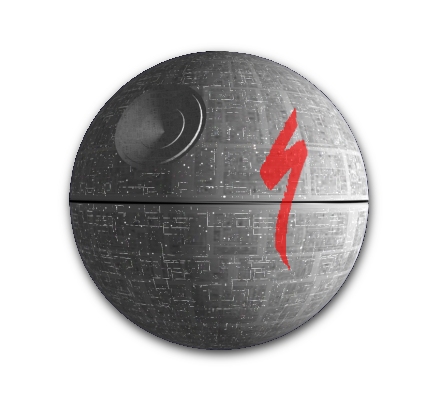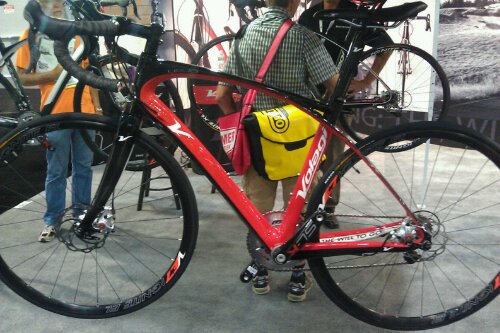Thanks to Facebook, we have a pretty accurate idea of exactly when the next major change in cycling took place. Before Cyclingnews drove the point home, phone camera shots of Colnago’s C59 Disc had already begun to surface. Given the time difference between the U.S. and Taiwan, it was around 3:30am that my friend Chuck posted a few photos of the Formula hydraulic disc levers on the C59 and TRP’s Di2 hydraulic levers. So let’s call it: 3:30am Eastern, Wednesday, March 7th, 2012, disc brake road bikes arrived.
Volagi certainly called it, and they deserve a lot of credit for taking a risk and going off the front of the pack so early. It’s moves like that that give small companies a foothold and a chance to grow, and it certainly looks like Volagi has the wherewithal to welcome more and more companies aboard. Personally, I tend to think the Liscio frame design Volagi’s created is actually pretty unique even without the disc brakes and leaf-sprung top-tube/seat stay design Specialized liked so much. In some ways, the Liscio has more in common with “adventure” brands like Salsa than it does Colnago’s new C59–and that’s exactly why Taipei’s unveiling of hydraulic disc brakes on “pure” road bikes is so significant.
But what does it all mean? Should you panic? Rejoice? Hoard canned food? Here’re some things this will probably mean:
- Electronic shifting will become standard equipment on all high-end bikes. Yes it will. You need the interior space of the hood for a hydraulic master cylinder and piston, leaving no room for the clock-like shifter mechanics we once knew and loved. Big Winners: Shimano. Big Losers: SRAM and Campy. (Campy made a valiant effort there, but everybody is going to design around the Shimano electronic shifting system.)
- At least some crazy shit is bound to happen. Yeah, Tyler shouldn’t have been scrubbing his brakes so much on that descent, but the bottom line is that weird shit always happens when there’s a tectonic shift in the cycling industry, and there is a vague whiff of “let’s see what happens” out there regarding hydraulic discs on road bikes. Despite the best efforts of everyone involved, some small percentage of chaos will occur around this, likely including a whole lot of carbon fiber recycling. Despite all the amazing stress analysis and structural design programs out there, plenty of companies proved unable to build a basic ‘cross fork that didn’t howl like a banshee, and plenty of carbon fiber frameset manufacturers still find out the real durability of their stuff once the warranties start piling up. And let’s not even talk about wheels. Big Winners: Mayhem. Dentists. Big Losers: The unsuspecting.
- “Road” techs are going to get their asses handed to them. Plenty of great mountain bike mechanics can’t set the angle on STIs or Ergos to save their lives, but I’ve met more than a few bike techs from highly regarded boutique road-specific shops whom I’d not let within a kilometer of my hydraulic brakes. Most of these guys are gifted bike techs who just happen to lack any mechanical aptitude whatsoever–meaning they can install the hairiest of power meter equipment and they never forget to unwind their torque wrenches after each use, but changing light bulbs around the house is a challenge, and they haven’t the slightest idea what makes an automobile go. With even the best instructions, there are just fundamental mechanical things you need to know in order to make hydraulic disc brakes work consistently, and genuine road bikes with hydraulic disc brakes are going to force the issue. Big Winners: UBI, Lennard Zinn. Big Losers: The unsuspecting.
- Cyclocross bikes are going to be awesome. Seriously, electronic shifting with hydraulic disc brakes? A few possible cases of “rotor brand” aside, you’ll be able to tell the guys with the hydraulics, because they’ll be the ones riding one lap up on the field. At least until their bikes need serviced. In most ‘cross conditions, the differences will be dramatic. Big Winners: The 1%, sponsored athletes. Big Losers: Canti’s, “Suicide Levers,” people who race ‘cross in nice weather.
Now we sit back and watch each brand decide whether to adopt or not, and when. By this time next year, the road disc thing likely still won’t have sorted itself out completely, and we’ll be looking at the first waves of major 650b wheel size adopters. Sometimes, I’m happy not to be a product manager at a bike company.









